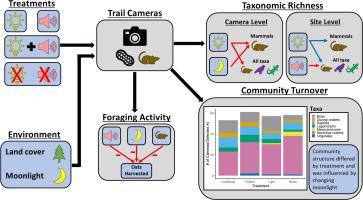Science of the Total Environment ( IF 8.2 ) Pub Date : 2021-09-09 , DOI: 10.1016/j.scitotenv.2021.150223 Joshua S Willems 1 , Jennifer N Phillips 2 , Clinton D Francis 3

|
Light and noise pollution from human activity are increasing at a dramatic rate. These sensory stimuli can have a wide range of effects on animal behavior, reproductive success, and physiology. However, less is known about the functional and community-level consequences of these sensory pollutants, especially when they co-occur. Using camera traps in a manipulative field experiment, we studied the effects of anthropogenic light and noise, singularly and in tandem, on richness and community turnover at both the taxa and functional group level as well as foraging activity. We showed that both light and noise pollution did alter taxonomic richness and that these effects can differ depending on the scale of observation. Increases in light levels had a negative effect on richness at the camera-level scale, but light-treated sites had the highest pooled (i.e., cumulative) richness of all treatment types. In contrast, noise was found to have a negative effect on cumulative richness; however, when both stimuli were present, the addition of night-lighting mitigated the effects of noise. Artificial light and moonlight had the strongest influence on community turnover, and results remained consistent at both the taxa and functional group level. Additionally, increases in ambient noise and moonlight, but not artificial light, reduced foraging activity. Our study provides evidence that alterations to the sensory environment can alter the richness and composition of communities and that effects can be scale-dependent and also alter foraging behavior. Unexpectedly, the addition of artificial light may have mitigated the negative effects of noise on cumulative taxonomic richness. This highlights the importance of researching the consequences of co-exposure to these globally common pollutants.
中文翻译:

夜间人造光和人为噪音改变了脊椎动物群落的觅食活动和结构
人类活动造成的光和噪音污染正以惊人的速度增加。这些感官刺激会对动物行为、繁殖成功和生理产生广泛的影响。然而,人们对这些感官污染物的功能和社区层面的后果知之甚少,尤其是当它们同时发生时。在操纵性现场实验中使用相机陷阱,我们研究了人为光和噪声对物种和功能群水平以及觅食活动的丰富度和群落更新的影响,单独和串联。我们表明光污染和噪音污染确实改变了分类丰富度,并且这些影响可能因观察规模而异。光照水平的增加对相机级别的丰富度有负面影响,但在所有处理类型中,光照处理的站点具有最高的汇集(即累积)丰富度。相比之下,噪音对累积丰富度有负面影响;然而,当两种刺激都存在时,夜间照明的增加减轻了噪音的影响。人造光和月光对群落周转的影响最大,结果在分类群和功能组水平上保持一致。此外,环境噪音和月光的增加,但不是人造光,减少了觅食活动。我们的研究提供的证据表明,感官环境的改变可以改变群落的丰富度和组成,而且影响可能与规模有关,也会改变觅食行为。不料,添加人造光可能减轻了噪音对累积分类丰富度的负面影响。这凸显了研究共同暴露于这些全球常见污染物的后果的重要性。











































 京公网安备 11010802027423号
京公网安备 11010802027423号